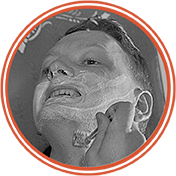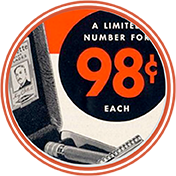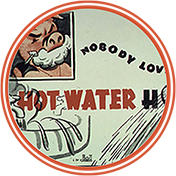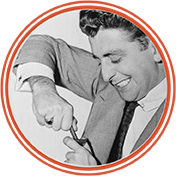
Classic double-edge (DE) safety razors have just one, extremely sharp blade that glides micrometers above the skin. The shave is simply amazing and without the irritation and stubble that you get from multiple blades.
Unlike multi-blade cartridge razors, safety razors are infinitely customizable: you can easily adjust your hand position and thus the angle of the blade; change to a sharper or gentler brand of blade; or in the case of adjustable razors, the gap between the guard and the blade.
Nicks and cuts? Once you get comfortable, it is similar to a cartridge razor, in our experience, very rare…it is called a safety razor for a reason! Of course there is a learning curve, but after a few shaves you will be fine.

Replacement safety razor blades are cheap, dirt cheap! 100 high-quality Platinum and Teflon coated blades cost between $5 and $30, or $.05 to $.30 cents each. If you change your blade every three shaves, one hundred blades will last about a year.
Save hundreds of dollars a year over regular multi-blade cartridge (such as the Fusion, Mach 3, Quattro, or disposable razors). Seriously. This is big money over time!
In an economy like ours, every last dime counts, and moving to a safety razor can save you and your family significant money. This is technology from the Great Depression – but with 21st century blades.

Double edge blades are incredibly efficient – just a single strip of metal, wrapped in a small piece of waxed paper, and in a small container the size of a matchbox.
Even with the packaging, they have up to 97% less material than disposables.
According to the EPA, two billion disposable razors are landfilled annually.

Learning Curve – Like many new skills, it takes a bit of time to learn to use a Safety Razor. Usually after the first week, it feels like second nature, but there are always new techniques to learn in pursuit of a Baby Bottom Smooth (BBS) shave.
Time – it takes a bit longer to shave with a safety razor than with multi-blade ExtremeMachHydroFusion cartridges. Between lathering and shaving, it can take five to ten minutes. However, these meditative moments are a great way to start
Upfront Cost – While the savings come from the ten-cent replacement blades, your first safety razor and double-edge blades will cost between $20 and $100, with $50 being the sweet spot.
Since 2007, RetroRazor has made choosing a safety razor kit simple. With thousands of combinations of razor, blade, brush and soap, it is easy to be overwhelmed, but we are here to help you find the best value in old-school shaving for your budget.
In the links below you will find our absolute favorite shaving products, hand selected and field tested - and most with free shipping and the Amazon A-Z Guarantee
Every new business looks for ways to save time, cut costs, and boost sales. “As the head of a start-up with no money, I use as many free tools as possible,” says Chadd Bennett, founder of RetroRazor. Here are 10 free or inexpensive Web-based services that he recommends.

Links:
[1] http://www2.inc.com/sites/default/files/slideshows/01_37.jpg
[2] http://www2.inc.com/sites/default/files/slideshows/02_33.jpg
[3] http://www2.inc.com/sites/default/files/slideshows/03_30.jpg
[4] http://www2.inc.com/sites/default/files/slideshows/04_33.jpg
[5] http://www2.inc.com/sites/default/files/slideshows/05_27.jpg
[6] http://www2.inc.com/sites/default/files/slideshows/06_25.jpg
[7] http://www2.inc.com/sites/default/files/slideshows/07_19.jpg
[8] http://www2.inc.com/sites/default/files/slideshows/08_17.jpg
[9] http://www2.inc.com/sites/default/files/slideshows/09_14.jpg
[10] http://www2.inc.com/sites/default/files/slideshows/10_10.jpg
[11] http://blog.inc.com/quick-hits/2009/05/our_favorite_iphone_apps.html
[12] http://www.inc.com/magazine/20090501/sales-and-marketing-e-mails-that-sell.html
[13] http://www.inc.com/ss/7-businesses-watch-out
[14] http://www.inc.com/ss/12-cool-web-tools-small-business
[15] http://www.inc.com/ss/11-businesses-you-can-start-your-pajamas-2009
Barely safe for work…If my mother in law saw this, it would make me a bit uncomfortable!
From Wikipedia:
The original version of “Shaving Cream” was issued on Benny’s record label with Phil Winston on vocals under the pseudonym Paul Wynn, and as that name was also used by Bell himself, Winston’s version has often been mistaken for Bell’s, and has appeared on Benny Bell compilation albums more frequently than Bell’s own version. “Shaving Cream” uses a technique in which each verse suggests a rhyme with a certain rude word, but drops two beats before the chorus, which replaces the word with the title. The same concept was used in “Sweet Violets” and many other songs that Benny recorded.
RetroRazor and Finished Lines Barbershop were featured by Jesse Jones and Dino Delarosa for King5 Television’s Get Jesse spot on Friday, April 3rd.
The RetroRazor and the Straight Razor (wielded by Gino Reyes, owner of Finished Lines) were pitted against each other in a shave off. The faces of Orion Baker and Ben Gomes were the playing field; It was a close match – watch the video for the outcome:
RetroRazor vs. Straight Razor
RetroRazor: Faster, cheaper, convenient, darn close shave
Barber Straight: Slightly closer shave, community, perfect for special occasions
RetroRazor wins by a hair!
Precision blades are the hallmark of Double Edge shaving with a Safety Razor; as you can customize your brand to your preference. Many users try three or more blade manufacturers before settling on ‘their’ blade. Variables such as the grinding, coatings, and sharpness can vary the type of shave trememdously depending on your skin and beard type. This is why RetroRazor includes three types of blades to sample.
Here is a fascinating article about Personna American Safety Razor’s plant in Knoxville, TN. This plant is primarily producing Plastic Disposables for privalte label drug stores, but the segment about blade manufacture is very cool…This is the same company that makes the Red Personna’s, though ours are made in the Northern Israel plant. We also supply Korean and Turkish blades in our starter kit. RetroRazor is seeking out a domestic source of Razors as well for those who want to buy American!
“Personna American Safety Razor is a private-label supplier of consumer razor blades in the United States. “When you go into a Kroger [a Cincinnati-based grocery retailer] and they have a private-label razor, more than likely that is our razor. Our competition is Bic, Schick and Gillette, as well as other private-label manufacturers. We consider ourselves as competing in the overall wet shaving market, and private label is one aspect of that market,” says Kermit Bantz, director of shaving manufacturing at the Knoxville, TN, facility.”
skip a ton of QC things about plastic razors…
“The Manufacture of a Blade
Operators on the shop floor perform several inspections and quality checks throughout the manufacturing process, and it all begins with 3-mile-long strips of steel. ASR goes through about 25 to 30 coils of these strips each day. First, 2,000-degree furnaces harden the strips of steel at about 50 feet per minute. The strips are then cooled.
A strip from each coil goes offline to a Smart Scope for inspection. If the strip is out of spec, the entire coil will get scrapped. A statistical process control (SPC) system keeps track of all scrap and data from this point on through grinding.
Along the way, the steel strips are perforated. In 2004, the Knoxville plant had five presses. Today, to keep up with the increased production, the facility has eight. During the hardening process, the steel strips are at risk for stretching or breaking. ASR employs an inline vision system to check for these defects.
“Online detection is very important, because with 3 miles of steel, you can get a lot of bad product,” says Daron Roberts, value stream manager/production manager at the Knoxville plant.
To double-check the vision system used, an operator uses an offline stretch gage to check for stretching and straightness with a tolerance of about 4 /16 of an inch.
Next, the blades go to the grinding process to achieve their sharpness. Throughout the process, cameras measure blade height. Tolerance is approximately 1 /1,000 of an inch. Offline, an operator checks for blade appearance and edge quality with a microscope.
An in-house designed machine, called the Sharpometer, is used by an operator to check for balance of the blades—from edge to edge and front to back.
Blades then go through a cleaning and coating process. Sensors measure position of blades along the way and a vision system ensures that the coating was applied correctly and evenly. Blades are packaged in small boxes and wait for shipment to Mexico for assembly.
The test and inspection processes don’t stop after the blades are complete, however. “All products are shave tested annually and are tested against the brand name products,” says Anna Hickman, quality engineer and consumer quality manager for the wet shaving division. Hickman sends product samples to a third-party source for consumer testing regularly, as well as conducts in-house shave testing.
There are two lab technicians on staff responsible for customer quality issues. Offline, a scanning electron microscope at 10,000X to 30,000X power is used to determine how smooth or sharp the blade is and to look into customer issues. The microscope also is used to research the impact of different processes on the edge of the blade.
A couple of weeks ago, my publisher tossed a small package on my desk with a verbal message that went something like this: “They sent this to me by mistake.” Huh, I wondered as I took a look at what was inside the plain brown wrapper. To my surprise, the package contained an old-fashioned safety razor called the RetroRazor. Cool as a slab of South Dakota granite, I resisted the urge to race off to the men’s room to see if my beard looked particularly gnarly that day. Within an hour or so, I was able to quell the sick-to-my-stomach feeling that the big-boss might be telling me that he would prefer the fuzz off my face. Luckily, I remembered that I have never met anyone more direct and to the point than the captain of our ship. That’s when I decided to investigate this cool little shaver a little more thoroughly.

The RetroRazor is a lot like the device my dad used to hack his face to pieces every morning when I was a kid. Of course it was that he was so stingy with new razor blades that dad so often had those little bits of tissue stuck to his face when he headed out the door to work. I was as impressionable as the next youngster, so when it came time for me to shave – I mean really time – I chose a straight razor with strop. Heck, if the outlaw Josie Wales could shave with a straight razor, so could I. As luck would have it, I managed to avoid seriously injuring myself with the straight razor. I nicked my lip once pretty badly trying to trim-up my dripping-off-the-sides of-my-chin Wyatt Earp moustache, however. It was about then that I decided to enter the high-tech razor world; I’ve been looking for a simple, multi-bladed, fancy-named, tool that I could afford to use ever since.
Well, I believe that I have indeed found just the right razor. Actually my publisher found it and passed it on to me. The RetroRazor is a metalworking piece of art. It is fun to hold, it is beautiful to look at, there are no plastic buttons or snaps or levers to break off, and it uses regular old double-sided razor blades that are inexpensive and readily available. I used the RetroRazor to trim up my beard and shave my cheeks and neck over the weekend and it performed wonderfully. Not only did the RetroRazor work, but it worked better than my triple-bladed wonder with the super-expensive, proprietary blades. I am happy to report that my face, neck and Adam’s apple failed to shed any blood while receiving a close shave with the RetroRazor. This cool old-style shaver is now my all time favorite – so much so that I tossed all the fancy razors in the trash.
I still brood that our publisher was sending me a message when he dropped the RetroRazor on my desk. I suspect he was just being nice. In any case, I am tickled that he turned me on to the RetroRazor – it is the only shaver that, in my book, makes the cut.
Hank Will III is the editor of Grit Magazine.
GRIT is a bi-monthly magazine distributed throughout the United States and Canada that celebrates country lifestyles of all kinds, while emphasizing the importance of community and stewardship. As North America’s premier rural lifestyle title, GRIT publishes feature-length articles on a broad range of topics that appeal to those already living in the country and those who aspire to get there. Our readers are well-educated, successful and choose to live on the land for many reasons. Most do not depend on their soil for significant income – some choose not to work their land (in the conventional sense) at all. But all share an appreciation for life out where the pavement ends.
GRIT offers practical advice, product reviews, livestock guides, gardening, cooking and other do-it-yourself information, humor and the inspirational stories of folks who moved to the country and love it. Each issue covers topics related to country living, land management, wildlife, gardening, livestock or pets, skills and techniques, seasonal food, community, machinery or tools, and lifestyle events.
E-Mail // [email protected]
Updates // Subscribe RSS feed
to receive updates.